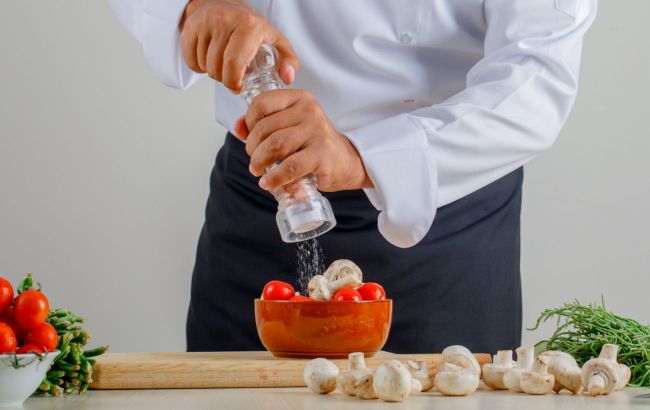Dietitian reveals whether adding salt to dishes worth it
 Adding salt to dishes worth it? (Photo: Freepik)
Adding salt to dishes worth it? (Photo: Freepik)
Everyone is used to adding salt to their food. However, both excess and deficiency of salt can harm the body. It is worth knowing who should exclude salt from their diet altogether, according to the medical community "Berezhy sebe" (Take care).
Chemical nature of salt
Salt has been used since ancient times (even before our era) primarily for preserving food. A salty environment is not suitable for the growth and reproduction of bacteria, as salt extracts the water that is essential for bacterial life.
Dietitian Tetiana Lakusta explained that salt (NaCl) is 40% sodium, which affects numerous physiological functions in the human body. This includes nervous conductivity, muscle tone, and water-electrolyte balance.
One should stick to the "golden mean" - both excess and deficiency of this chemical compound can harm the body.
Dangers of salt deficiency
Currently, the focus of attention is on salt overconsumption, and this is not surprising, as it is associated with serious consequences for the body.
However, it is essential not to forget that salt deficiency can also be dangerous.
Specifically, the consequences of NaCl deficiency may include:
- low blood pressure - sodium is an important player in maintaining normal pressure. When there is a deficiency, for example, due to dehydration (excessive sweating, diarrhea, vomiting, excessive use of diuretics), it can lead to lower pressure
- water balance disruption - sodium retains water, so the insufficient concentration of it allows excessive water to enter the cells
- sharp restriction can lead to an increase in LDL (low-density lipoproteins) and triglycerides in the blood
Salt norm
According to the recommendations of the U.S. Food and Drug Administration (FDA), the salt norm for adults is 6 grams, and the recommended sodium intake is 2.5 grams per day.
At the same time, recommended amounts vary widely among age groups. For example, salt and sodium intake for children aged 4-6 years should be limited to 3 grams and 1.2 grams, respectively.
Most of the added salt we consume comes from processed foods: bread, hard cheese, sausage products, salty snacks, pastries, and fast food.
Who should be cautious about salt
Everyone should adhere to salt consumption recommendations. However, especially people who have:
- diseases of the gastric mucosa, precancerous conditions, and stomach cancer
- osteoporosis or osteopenia - a decrease in bone tissue density. Increased consumption of salt increases calcium excretion through urine
- chronic kidney disease - in this case, salt consumption is recommended to be reduced by half of the daily norm for healthy individuals
- cardiovascular diseases - excessive salt consumption is associated with the development of hypertension, which is one of the main factors in the development of stroke and heart attack.
Is all salt the same
Among the most common types are:
- rock salt is extracted from natural sources - underground minerals, and does not contain iodine
- iodized salt - rock salt that is artificially enriched with iodine
- sea salt is formed by evaporating sea or ocean water. It consists of boiled salt with small impurities of minerals but with minimal iodine content
- kosher salt - large-grain salt that includes agents to prevent lump formation, used for preparing kosher dishes
- Himalayan or pink salt - extracted in Pakistan, contains natural impurities of iron oxide.
How to minimize salt intake
To reduce the amount of salt in the diet, you should follow these tips:
- exclude or limit the consumption of pickled vegetables, both homemade and store-bought
- reduce the consumption of bacon, salted fish, salted lard, as well as processed meat and fish products, and homemade dishes containing excessive salt
- use low-sodium salt (contains 30-40% potassium chloride instead of sodium chloride)
- try to partially replace salt in dishes with various spices and herbs to obtain different rich flavors
- add vegetables that are sources of potassium to each meal - for example, spinach, parsley, lettuce leaves, broccoli, peas, tomatoes, and potatoes.
This material is for informational purposes only and should not be used for medical diagnosis or self-treatment. Our goal is to provide readers with accurate information about symptoms, causes, and methods of detecting diseases. RBС-Ukraine is not responsible for any diagnoses that readers may make based on materials from the resource. We do not recommend self-treatment and advise consulting a doctor in case of any health concerns.

